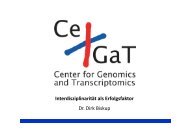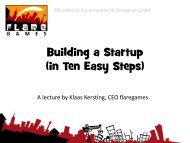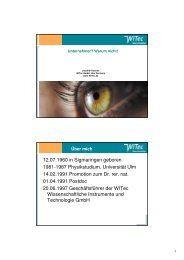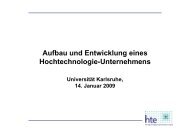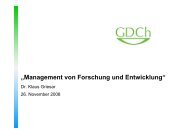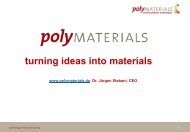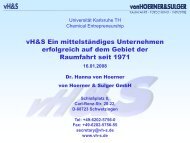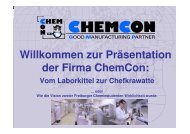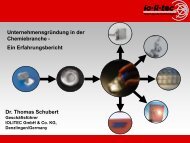Education in Chemical Entrepreneurship - KIT - Technology ...
Education in Chemical Entrepreneurship - KIT - Technology ...
Education in Chemical Entrepreneurship - KIT - Technology ...
Create successful ePaper yourself
Turn your PDF publications into a flip-book with our unique Google optimized e-Paper software.
Figure 3: Development of attendees’ course participation and their scientific or<br />
eng<strong>in</strong>eer<strong>in</strong>g discipl<strong>in</strong>es.<br />
As already found <strong>in</strong> the first questionnaire, the second questionnaire (10 respondents<br />
out of 15) corroborated many of the course design features and approaches (Figure 4).<br />
The attractiveness of the course for people from non-chemical discipl<strong>in</strong>es seems to be<br />
corroborated (roughly 50 percent of attendees are from fields not related to<br />
chemistry). When asked us<strong>in</strong>g a scale from 1 (Too much) to 5 (Too little) how much<br />
the course is related to chemical content the average answer was 3.0 (About right)<br />
with no extreme answers (1 or 5). The (welcomed) relative broad variety of attendees’<br />
discipl<strong>in</strong>es for a course dedicated to “chemistry” by title can be partially, but<br />
tentatively, attributed to the modular character which allows students and others to<br />
selectively attend a meet<strong>in</strong>g just of <strong>in</strong>terest to them.<br />
It does not appear as a surprise that a scientific/eng<strong>in</strong>eer<strong>in</strong>g population confronted<br />
with content which is far off their ma<strong>in</strong>stream study or completed education viewed<br />
the content of the course as medium difficult (Figure 4; left), its scope as widerang<strong>in</strong>g<br />
and the use of special terms or phrases outside the attendee’s ma<strong>in</strong>stream<br />
discipl<strong>in</strong>e as just acceptable. On the other hand, participants confirmed that only little<br />
prelim<strong>in</strong>ary knowledge is required to benefit from the course and evidence and lucid<br />
examples provided <strong>in</strong> the course together with the appropriateness of teach<strong>in</strong>g and<br />
learn<strong>in</strong>g material seemed to enforce the attractiveness of the course for a comb<strong>in</strong>ed<br />
science and eng<strong>in</strong>eer<strong>in</strong>g oriented population. Moreover, the goal of provid<strong>in</strong>g a<br />
“Theory-to-Practice” approach has been fully met (Figure 4; right). The assessment of<br />
the <strong>in</strong>structor exhibits very positive rat<strong>in</strong>gs, except for the perception of the<br />
stimulat<strong>in</strong>g style of the <strong>in</strong>structor’s presentation.<br />
In Figure 5 further assessments of the course format and benefits for the attendees are<br />
presented, corroborat<strong>in</strong>g the modular design of the course and the very high<br />
importance of <strong>in</strong>tegrat<strong>in</strong>g lectures by external guest speakers. Furthermore, 100<br />
percent of the attendees confirmed that they do not need the given references and<br />
sources to understand the course content. Concern<strong>in</strong>g benefits for the attendees Figure<br />
5 (right) shows that the goals of the course have been fully met and correspond<strong>in</strong>gly<br />
attendees perceived the relevance of the course for their further studies or lives,<br />
respectively. The overall assessment of the course (1.8) fits with the fact that 100<br />
Runge and Bräse - 17 -



